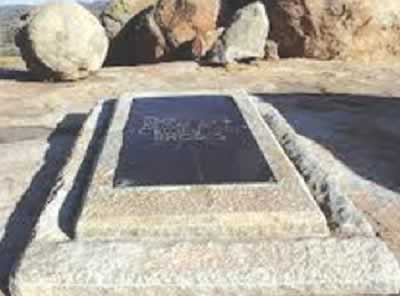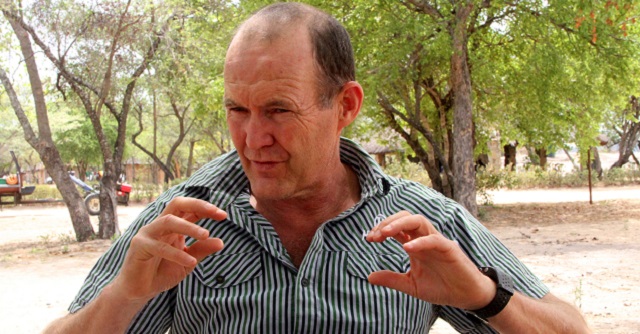
The Sunday News

 Tinomuda Chakanyuka
Tinomuda Chakanyuka
THE Cape Town University council, on Wednesday 8 April unanimously voted for the removal of colonialist Cecil John Rhodes’ statue from the university campus.
This followed weeks of protest by students at the institution who demanded the removal of the monument with some activists having thrown excrement on the statue.
The matter which has been dubbed the “Rhodes Must Fall” debate also sparked defacement of other colonial era monuments around South Africa, including a statue of King George VI at the University of KwaZulu-Natal and the splashing of green paint on a statue of Paul Kruger in Pretoria.
Debate on the fate of colonial era monuments has not only been confined to South Africa. Zimbabwe, which shares an almost similar colonial heritage with its southern neighbour, has also been seized with similar discourse for quite some time.
Zimbabwe, a former colony of Britain habours over 40 colonial era monuments with Rhodes’ grave in Matobo district probably headlining the collection.
The developments in South Africa have seen ignition of fierce public debate on the continued preservation of artifacts and monuments that bear the country’s colonial history.
As the country draws closer to marking its 35th Uhuru celebrations, the debate on the matter has flared with some quarters radically calling for the annihilation of the monuments and artefacts.
Such calls are premised on the argument that the continued preservation of such artefacts and monuments with colonial history was tantamount to celebrating colonialism.
Without doubt colonialism ranks as the height of the West’s barbarism against other races, of course after the infamous slave trade which saw over 20 million black Africans being shipped to America and Europe to be enslaved in plantations.
Again it cannot be contested that colonialism and slave trade, to Africans who were on the receiving end of the two systems, remain the darkest periods of the continent’s history.
Thus from an African perspective, celebrating such dark epochs or any action that smacks of such is utterly inexcusable. In this context the anger being directed towards colonial monuments and artefacts by those calling for their removal is understandable.
Bulawayo City Council (BCC) recently came under fire for its decision to uncover a plaque that some sections of society regard to be demeaning people from Matabeleland.
The Indaba plaque at the main entrance of the City Hall’s municipal offices, depicts Rhodes seated on a higher rock, during peace negotiations with leaders of the Ndebele Kingdom who were sitting on the ground.
City fathers have justified their move saying the plaque had historical significance for Bulawayo.
Rhodes’ grave in Matopo has also been targeted by those calling for the obliteration of colonial artefacts and monuments, as they continuously urge authorities to exhume the colonialist’s remains and repatriate them.
Sometime in 2012, Government blocked plans by war veterans to exhume Rhodes’ grave and return his remains to the United Kingdom, saying his legacy was part of the national history. The war vets blamed the existence of Rhodes’ grave for the drought that hit some parts of the country.
As debate around the colonial artefacts and monuments continues there are a lot of questions that recur and are begging for answers.
President Mugabe, who was in South Africa on a State visit last week, tapped into the “Rhodes Must Fall,” debate and said, “So we are looking after the corpse and you have the statue. I don’t know what you think we should do. Dig him up? Perhaps his spirit might rise again, what shall we do?”
Questions that are constantly brought up in the colonial monuments and artefacts debate are: Is preserving the artefacts and monuments in any way some form of celebrating the domination of indigenous people by white settlers? Is the continued preservation of the artefacts and monuments a sign of the West’s continued dominance, and an appendage of their neocolonialism agenda? Is it by any means an insult to national pride?
On the flip side of the debate, one may also ask if the complete destruction of the monuments will help us forget or perhaps rewrite the colonial history? Should we even forget that history and what do we stand to benefit from deliberately editing our history. Will our future generations be any wiser if they don’t know their complete history, including the darkest parts of it? As we get into Independence celebration mood, will it help us in any way to celebrate freedom without fully knowing and appreciating that from which we were freed?
If all these questions and several others around the subject are answered satisfactorily and honestly, without malice, the debate on how the nation should treat the monuments and artefacts may come to a logical end.
It should also be noted that there is a difference between celebrating a history and remembering it. What role the artefacts and monuments play in each of the two gestures, is yet another question that if answered may also put the discourse to rest.
In the 1980s the National Museums and Monuments of Zimbabwe (NMMZ) ordered the removal of Rhodes’ statue which was situated at the intersection of Main Street (now Joshua Mqabuko Nkomo Street) and 8th Avenue.
Director of the National Museums and Monuments of Zimbabwe (NMMZ) Dr Godfrey Mahachi said preservation of such artefacts and monuments was not a sign of celebrating colonialism, but was a way of appreciating the country’s colonial heritage.
He said remembering our colonial heritage serves to give us legitimacy as a nation and helps us learn from our past mistakes.
Dr Mahachi added that recording the country’s history should not be about editing aspects of our past that we don’t like but accurately capturing every aspect of our history.
He, however, pointed out that placement of monuments and the prominence given to such monoliths differentiated between simple preservation and commemoration of colonial history.
“Rhodes’ grave is just a grave and we don’t celebrate it in any way. It is there so that we remember the person and system we defeated to attain our independence. That grave does not in any way compare to our National Heroes’ Acre. The heroes’ acre is placed at a prominent place, where everyone can see to show that we actually celebrate that part of our history which brought us independence.
“It is the case with all monuments and artefacts that we use to celebrate our history, they are deliberately placed in prominent places. Those that have a colonial history and only serve to remind us of that part of the history are carefully placed in places such as our museums, not in public places. This is why soon after attaining independence we had to pull down Rhodes’ statue and put it somewhere in our museum,” he said.
Dr Mahachi said the country could not pretend that colonial history did not exist, adding that if there were places that reminded the nation of such times they should be known.
Dr Mahachi’s sentiments were echoed by Mr Peter Zwide KaLanga Khumalo, a descendant of the Ndebele king, Lobengula who regarded as mere activists’ emotions calls for the removal of the plaque and exhumation of Rhodes’ remains.
“If we remove that plaque because it reminds us of Rhodes then why don’t we go around destroying all the buildings in the city that were built during the colonial regime, I view this as mere activists’ emotions because we just cannot go around removing plaques and digging up graves.
“Those who are saying this plaque should be taken to the museum should think what role it will play at the museum which is different from the role it is playing at the City Hall, this plaque represents a part of the history of Zimbabwe and the Ndebele in particular,” said Mr Khumalo.
Below are some of the colonial monuments on the national monuments list, their locations and brief profiles.
World’s view hill (Matobo)
A site commemorating the burial place of Cecil John Rhodes and other colonial founders.
Shangani Battlefield-Memorial (Bubi/Umguza)
A monument that marks the place where Allan Wilson and his party were killed by allegedly fleeing Matabele people under King Lobengula.
Old Jesuit Mission — Sauerdale (Bulawayo)
Site of the first Jesuit mission station to be opened by the Jesuit Fathers in the country. This monument is located near the site of Old Bulawayo, Ndebele King Lobengula’s capital which he abandoned in the early 1880s.
Memorial Cross (Mutare)
A memorial cross erected in honour of black native soldiers who participated in the Great War of 1914-18.
Old Mangwe Fort (Bulilima-Mangwe)
A fort built in 1893 to guard the Mangwe Pass and the road to Bulawayo.
Mangwe Memorial (Bulilima-Mangwe)
A granite obelski erected in 1954 in memory of people who travelled through the Mangwe Pass prior to the occupation of the country.
Blakiston-Routledge Memorial (Mazoe)
A memorial situated at Irene Farm in Mazoe area, erected to commemorate people who were killed in the 1896 rebellion.
Filabusi Memorial (Insiza)
A memorial erected to commemorate people who died in the Filabusi area during the 1896 war.
Mambo Memorial (Bubi/Umguza)
A memorial located at Mambo Farm near Gweru, erected to commemorate people who died during the 1896 war.
Fort Rixon Memorial (Fort Rixon)
This fort was built after the rebellion of 1896 as a laager for the white people residing in the Fort Rixon area. There is also a small cemetery containing graves of people (white) who were killed during the uprising.
Harare Toposcope (Harare)
Site that commemorates the place where the flag (Union Jack) was hoisted by the Pioneer Column on 12 September 1890.
Rhodes Indaba Site (Matobo)
A fenced anthill located in the Matopos National Park where Cecil Rhodes and his accomplices are reported to have sat on during their Indaba with Matabele leaders in a bid to end the war of 1896.
Fort Umlugulu (Bulawayo)
A defence fort built during the 1896 rebellion. It was also at this site that Baden Powell, a member of the small party that used the fort is reputed to have first mooted the idea of forming a Boy Scout movement. Furthermore, it was also from this site that a J P Richardson, a Native Commissioner and Zulu Linguist was reported to have taken a great personal risk by venturing into the hills in a bid to arrange meetings with the Ndebele elders. His efforts culminated in the Indaba that took place at the Rhodes Indaba site.
Rhodes’ Summer House (Matobo)
The original of this house was destroyed by veld fires. However, an replica of the building was then constructed to replace the destroyed one. The significance of the house is that it was used by Cecil J. Rhodes as a dining room during his visits to this country, especially during the hot season.
Rhodes’ Stable (Matobo)
An example of a Victorian Stable. This building located on the land of the Matopos Research Station was built on the instruction of Cecil John Rhodes through his farm manager, Mr Hull.
J Lee’s House-Bulilima (Mangwe)
Ruins of a building that was used by J Lee, the first hunter to settle in the Mangwe District in 1866.
Old Mission Site-London Missionary Society, Inyathi
Site of the first ever mission station to be established in the country. This particular mission station was opened by Robert Moffat’s London Missionary Society in 1859 after having been granted permission to do so by the Ndebele King Mzilikazi.
Rhodes’ Hut (Bulawayo)
This small thatched rondavel built on the site of King Lobengula’s capital was used as sleeping quarters by Cecil John Rhodes on his visits to Bulawayo.
Fort Tuli (Gwanda)
This fort was the first to be built by the Pioneer Column in this country when they crossed the Shashi River. Just adjacent to the site of Fort Tuli are also the remains of the first ever hospital to be established in the country and run by Mother Patrick and her Dominican sisters.
Fort Martin (Chegutu)
A fort established by Captain R C Nesbitt and named after Sir Richard Martin then overall commander of all the invading Rhodesian forces. This site which is located in the Chegutu area was built in a bid to subdue Chief Mashayamombe, one of the most outstanding Shona leaders in the 1896 war of resistance against colonial intrusion.
Fort Gibbs (Gweru)
A fort built by Captain J A C Gibbs during the rebellion of 1893 in Gweru. This fort was used again in 1896 by the British South African Police (BSAP) and abandoned after the conclusion of that war.
Laager Site, Battle of Bembesi (Bulawayo)
A monument in honour of those who died at the battle of Mbembesi in 1893.
Site of the battle of Bembesi (Bulawayo)
A monument that commemorates the site of the 1893 battle between the Matabele forces and the invading colonial armies.
Selous House (Mzingwane)
This monument comprises ruins of a house once occupied by Fredrick Courtney Selous one of the first white hunters to visit this country.
MacDougall Weir,Canals and Tunnel (Chiredzi)
This monument depicts the remnants of the first irrigation canals, tunnels and weirs that were used to draw water from the Mtirikwe River to irrigate the sugar cane fields at Triangle ranch.
Fort Mazoe (Mazoe)
A fort built during the 1896 war as a means of regaining control of the Mazoe Valley after the settlers had retreated. It was from this site that a full scale offensive against the Hwata people was launched from after initial negotiations had broken down. The graves of Blackstone, Routledge, Faull, Dicknson, Cass, Jacobs and Van Staaden are also located near this fort.
Old Fort Victoria (Masvingo)
Monument depicts remnants of a fort that was built by the Pioneer Column in 1890 during its trek that resulted in the occupation of Mashonaland.
Horse Trough (Victoria) (Bulawayo)
A cast iron Victorian Horse trough standing outside the stables in the grounds of the Government House in Bulawayo.
Matopo Railway Terminus (Bulawayo)
Site of the railway terminus that was built for the train services to the Matopo hills.
The Trek Memorial, Chimanimani (Chimanimani)
Memorial constructed in honour of the first white settlers to settle in the Chimanimani District.
Coach House and Stables (Bulawayo)
This coach house located on the grounds of the Government House in Bulawayo contains Victorian iron and wood work and was used by Cecil Rhodes during his visits to Bulawayo.
Mother Patrick’s Mortuary — Pioneer Hospital (Harare)
A small building used as the first pioneer mortuary in Harare. The building also illustrates the great work done by Mother Patrick, the first person to run a hospital in the city.
Settler Tree (Mutare)
This tree which is located in the grounds of the Magistrates’ courts in Mutare was planted by Don Luize Filipe, Duke of Braganza and Crown Prince of Portugal to commemorate his visit to the City of Mutare in 1907.
Paper House (Kwekwe)
Remnants of paper house built in Kwekwe in the early 1900.
BSA Co Lion — Government House (Bulawayo)
A cast iron standing on a granite plinth erected just adjacent to the main gate of the Government House in Bulawayo.
Old Foot Bridge (Kwekwe)
The first footbridge in the country, built to cross the Bembezana river on the Kwekwe to Mvuma road.
Site of Telegraph Office (Mazoe)
A fenced site containing the remnants of a pole and dagga telegraph office from which Blackstone and Routledge warned Harare of the attack on Alice Mine during the 1896 Mashona risings.
Fort Alderson (Mazoe)
A defensive fort built towards the end of the 1896 war on the instruction of Lt Col E A H Alderson then officer commanding Mashonaland Field Force. This fort just like the others in this area was built to defend the Mazoe Valley during the 1896 war.
MacDougall Homestead — Triangle (Chiredzi)
Original home of MacDougall, one of the first white settlers to occupy Zimbabwe’s southern Lowveld.
Cecil House (Harare)
A building constructed in 1901 and accommodated the De Beers offices.
“Utopia” — Home of R S Fairbridge (Mutare)
This monument is the home of R S Fairbridge.
Missionary Tree (Bulawayo)



